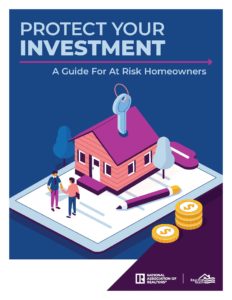
As Forbearance Confusion Persists, Help Set Owners Straight
Varying messages circulating about forbearance and payback options for homeowners are prompting confusion and potentially putting those borrowers at risk, speakers said Tuesday during the virtual Federal Financing & Housing Policy Committee meeting at the 2020 REALTORS® Legislative Meetings.
REALTORS® can be an important partner for homeowners needing access to correct information during this time, said Megan Booth, NAR’s director of federal housing, valuation, commercial real estate policy and programs, during the meeting.
Forbearance is the process of delaying mortgage payments for a given period of time. So far, about 3.5 million homeowners have obtained forbearance for their home loans over the last month and a half due to financial hardship from the pandemic.
But differing messages from mortgage servicers persist.
“For consumers who are trying to access relief options, we don’t want them to lose their home because they end up owing $9,000 or so from having not paid their mortgage after four months in forbearance,” Booth said. “If they have a federally backed mortgage, that shouldn’t be happening.”
The National Association of REALTORS® is producing brochures that real estate professionals can share with at-risk homeowners about accessing mortgage forbearance options during this period. Brochures can be customized with REALTORS®’ contact information.
The first brochure—currently available at realtorparty.realtor—is called “Protect Your Investment.” It outlines what homeowners should ask lenders about their options and payback when weighing forbearance.
Customize "Protect Your Investment"
Help homeowners who are struggling to meet their loan obligations by sharing Protect Your Investment. This brochure encourages homeowners to work with REALTORS® and housing counselors and offers guidance on options provided by lenders.
Associations and REALTORS® may add their logo to the cover for a customized look.
Please ensure that your logo is placed only in the designated white space. Your logo should be flush left (along the left margin) and not close to the NAR logo. To add the logo:
- Save Protect Your Investment as a .pdf
- Open the document with Adobe Acrobat
- Right-click on the white space to the left of the NAR logo; select “Add Image”
- Select the image file and click “Open”
- Use the mouse to position the image in the white space; left-click to paste the image
- To reposition, left click and hold down the mouse on the image and move as needed
- To resize, hover the mouse over a corner of the image until you see a double arrow, then left click and hold; drag the mouse to the left to make the image smaller or to the right to make larger
- Save the changes
Questions? Contact Wendy Penn at NAR: 202-383-7504.
Last week, the Federal Housing Finance Agency, which oversees Fannie Mae and Freddie Mac, attempted to clear up conflicting messages on paying back missed payments after a forbearance period. The FHFA clarified that it would not require homeowners who take mortgage forbearance to make up all missed payments in one lump sum. A payment plan could be worked out with the servicer.
Also at Tuesday’s meeting, Booth announced that NAR also will soon release a one-page pamphlet by the end of May for members to share with homeowners about another source of confusion over forbearance: how it shows up on credit reports. The CARES Act specifies that when a borrower arranges a forbearance option with their lender on an FHFA, Fannie Mae, or Freddie Mac–backed loan, servicers are required to report them as “current” on their mortgage.
Anecdotally, Booth said borrowers are reporting that some servicers are saying that any missed payments in forbearance would be a strike on a credit report. “We need to protect consumers during this time,” Booth said. “We need to share with clients what the law says. … We want them to be informed about what is happening and make sure the servicer is guiding them correctly. REALTORS® can be a trusted adviser and help them to know what to do.”
In another discussion during Tuesday’s committee meeting, members shared continued advocacy efforts to keep mortgage funds flowing during the pandemic. Melanie Barker, vice chair of the committee, said that while the FHFA has not changed its underwriting standards, she acknowledged that lenders are putting in stricter overlays that have made it tougher to qualify for a mortgage, such as higher down payments or credit score requirements. “Lenders are facing significant issues with liquidity,” Barker said. NAR continues to advocate for the formation of a liquidity facility to be set up by the Fed and backed up by the U.S. Treasury to provide a pool of money that servicers can use to make short-term loans and help ensure the stability of the housing finance market.
Meanwhile, Veterans Affairs loans have not changed their underwriting standards and are still available for veterans looking to buy a home during this time, said John Bell, deputy director of the Loan Guaranty Service, during Tuesday’s virtual committee meeting. They are continuing to process jumbo VA loans at competitive rates, Bell said. Also, as of Jan. 1, there is no upper loan limit on VA mortgages.
The VA program has adapted processes to keep transactions on track, such as requiring appraisers to set up appointments within 48 hours of contact, permitting desktop appraisals in some cases, and making plans to soon become the first government agency to allow end-to-end closing fully electronic and virtual, including remote online notarizations.
“We want veterans in homes, and we want to make sure they can still take advantage of the benefit they are eligible for,” Bell said.
Source: "As Forbearance Confusion Persists, Help Set Owners Straight"











Comments